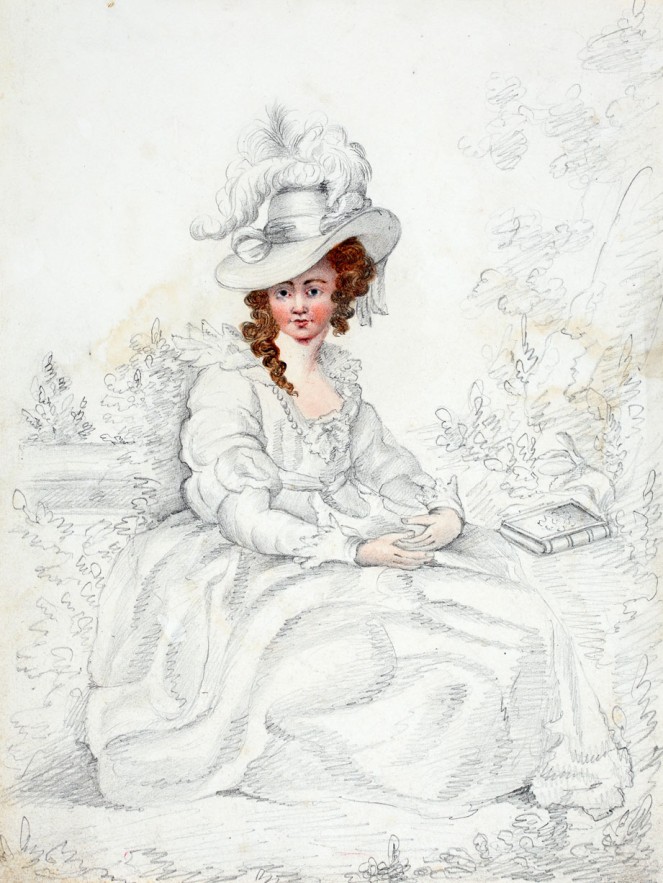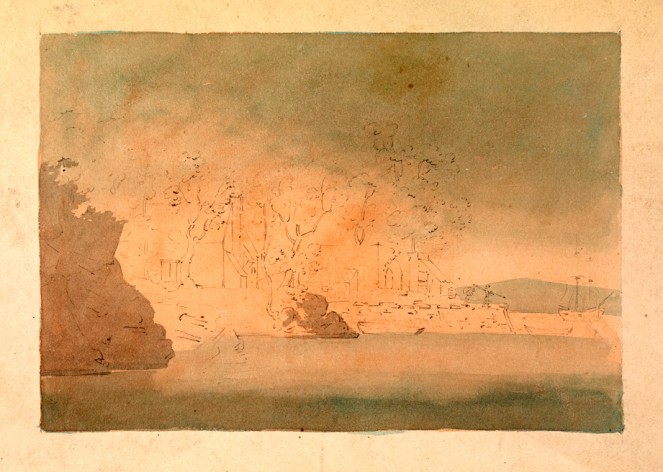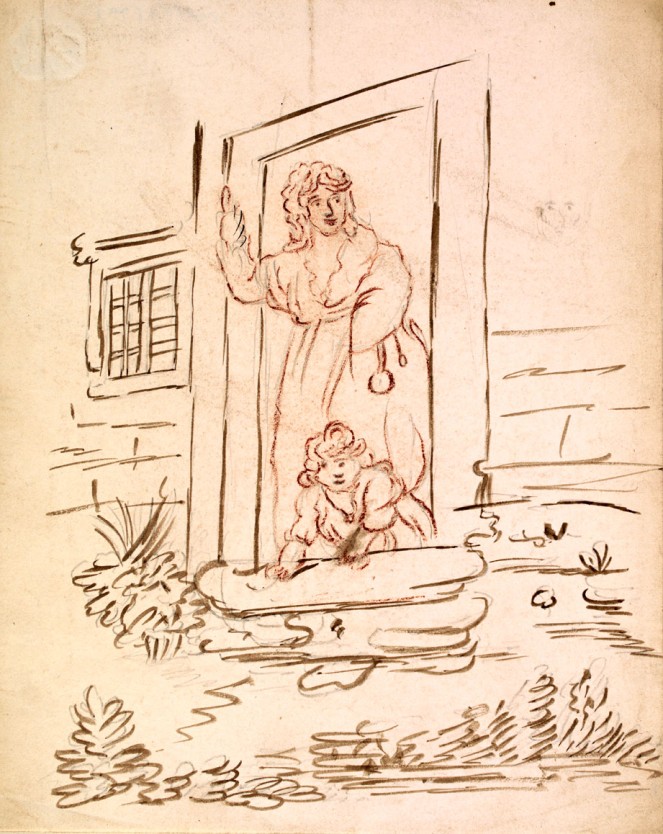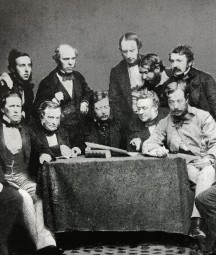by Abigail Rieley, writer and journalist
Hidden in the National Library’s collection of prints and drawings is the face of a murder victim. Maria Louisa Kirwan died exactly 160 years ago. She was killed by her husband on Ireland’s Eye, the barren little island that lies just off Howth in North County Dublin on September 6th 1852. It’s not surprising to find mention of her death in the Library collection but what is astonishing is to find her smiling out of a picture, looking into the eyes of the painter, her husband and her killer, William Bourke Kirwan.

Maria Kirwan. In enigmatic pencil on the back are the words "Mrs Kirwan sketched by her husband". NLI ref. 2085 TX 16
It didn’t take long for suspicion to fall on William Kirwan. He had been the only other person on the island when Maria met her death. If she hadn’t died by her own hand or by natural causes he was the obvious suspect. His trial was a sensation in both Ireland and Britain. The prosecution had been due to have been led by the Attorney General himself and Kirwan’s defence was headed by MP Isaac Butt. Huge crowds gathered outside the courtroom on each of the three days of the trial and after his conviction newspapers on both sides of the Irish Sea printed pages upon pages of rumour, gossip and opinion.
The Library collection has quite a few references to the case. It was one of the most famous Irish murders of the 19th Century. But it’s the pictorial record of the case that’s unique, created by the killer himself. William Kirwan didn’t plan to record his crime but the collection does act as a roadmap to the more scandalous details if you know where to look. It’s actually a fluke that it’s survived - Kirwan was not a gifted artist. If it wasn’t for his notoriety and the foresight of one of the Library’s greatest contributors, this roadmap would have vanished without trace.

One of three sunsets in the Kirwan Collection. William Kirwan claimed at various stages that a sketch he had done of the sunset on the day of his wife's death proved he could not have killed her! NLI ref. 2085 TX 89
The Kirwan Collection is an odd thing. There are a couple of finished paintings, in watercolour on paper but most of it is made up of odd scraps, unfinished sketches, doodles, fragments of accounts. As a record of someone’s artistic achievement it really doesn’t make sense. But as a pictorial insight into the mind of a murderer, selected by someone with a thorough knowledge of the case, it’s astonishing. There is Maria’s picture, on the back of which someone has helpfully written “Mrs Kirwan, sketched by her husband”. Several sunset sea scenes hint at one of the key points of Kirwan’s defence. At his trial he offered his sketchbook to the jury, so that they could see his alibi there. He couldn’t possibly have been killing his wife if he had been busy painting the sunset! But there are other pictures that stray from the evidence at the trial to the scandalous second family Kirwan was known to keep. A grieving woman and child by a gravestone could be hinting at Kirwan’s own loss, with his mistress, of their first child, the eldest of nine. That mistress, Theresa Kenny, might also appear as a bored nude. The children showing up in affectionate domestic sketches with heads full of unruly dark curls – just like their father? If you know the facts of the case the Kirwan Collection makes very interesting viewing.
So how did this rather scurrilous collection end up in the vaults at Library Towers? There’s no bill of sale to track exactly where these paintings and sketches came from but a bit of digging uncovers a very plausible solution.
When William Kirwan was convicted, everything he owned was confiscated by the British Crown, which then proceeded to sell everything off to liquidate his estate. In September 1853, almost exactly a year after Maria’s death, the Freeman’s Journal carried a notice about a public auction of the contents of the Merrion Street house where the Kirwan’s had lived. There were to be three auctions. The paintings, along with Kirwan’s art supplies, were to be sold on the second day. For the three days of viewings a steady of stream of members of the public had paraded through the infamous house but on the second day of actual bidding the Freeman’s Journal noted approvingly “As the pictures and drawings only were put up for sale, the company was of a different class from those who attended on the previous day, and included several members of the aristocracy.”

A water colour that may be a reference to the death of Kirwan's first child with his mistress. It is entirely possible that the model is William Kirwan's mistress, Theresa Kenny, with another of their children in her lap. NLI ref. 2085 TX 20
The Freeman’s notes that bidding was brisk for the art work, which included a mix of Kirwan’s own work and items he had been restoring or copying as part of his secondary business. The reporter was not a fan of Kirwan’s work, “the majority very inferior productions”, but concedes that bidding was brisk, especially for a framed miniature of a lady, reportedly Maria Kirwan herself which sold for three guineas.
The titled finished pictures that are named in the press coverage of the auction do not appear in the National Library collection so it makes sense that the collection is made up of the scraps that were found in Kirwan’s workroom. The notice for the next day’s auction, when the remainder of the paintings would be sold refers to sketches and notebooks. This would be where the collection came from.
But who was bidding? That answer can be found stamped on the back of several of the sketches. A circular stamp identifies them as belonging to The Joly Collection. Dr Jaspar Robert Joly was one of the biggest early contributors to the Library collection after he donated his considerable library to the Royal Dublin Society in 1863. Dr Joly was also a barrister. The Kirwan case was seen as significant. It was expected to change the law, allowing for second trials if new evidence was discovered. It’s reasonable to assume that Dr Joly could have made his way down to Green Street courthouse to see Kirwan sentenced on December 10th 1852. It also makes sense that he made his way to 11 Merrion Street Upper on September 16th the following year to add to his impressive collection of paintings.

Could this be Theresa Kenny and one of their children waving goodbye to William Kirwan as he returned home to his wife? NLI ref. 2085 TX 79
It was a good day to attend the bidding, with more than a whiff of scandal in the air. The Freeman’s Journal rather gleefully describes how Henry Brocas Jnr, himself a noted artist, stopped the auction with the accusation that the painting about to go on sale, which was signed with Kirwan’s signature, was actually the work of his father, Henry Brocas Snr. “It appears that the artist, who was a mere dauber, and scarcely deserving of the term “artist” was in the habit of attaching his name to the drawings of eminent water colour painters, and passing them off as his own.” The auction was stopped and the auctioneer carefully examined the signature. It was indeed a fraud. The painting and several others were removed from the sale.
While interruptions like this must have enlivened the day considerably, Dr Joly’s selection does not appear to contain any fraudulent sketches – although quite a few do look as if they are copies of existing subjects. Taken individually the pictures in the Kirwan Collection might be lacking in skill but as an insight into the man who created them, they are priceless.
Abigail Rieley is a writer and journalist. She is currently working on a novel based on the Kirwan case and also blogs at www.abigailrieley.com. You can read more about this murder in An Irishwoman's Diary...

